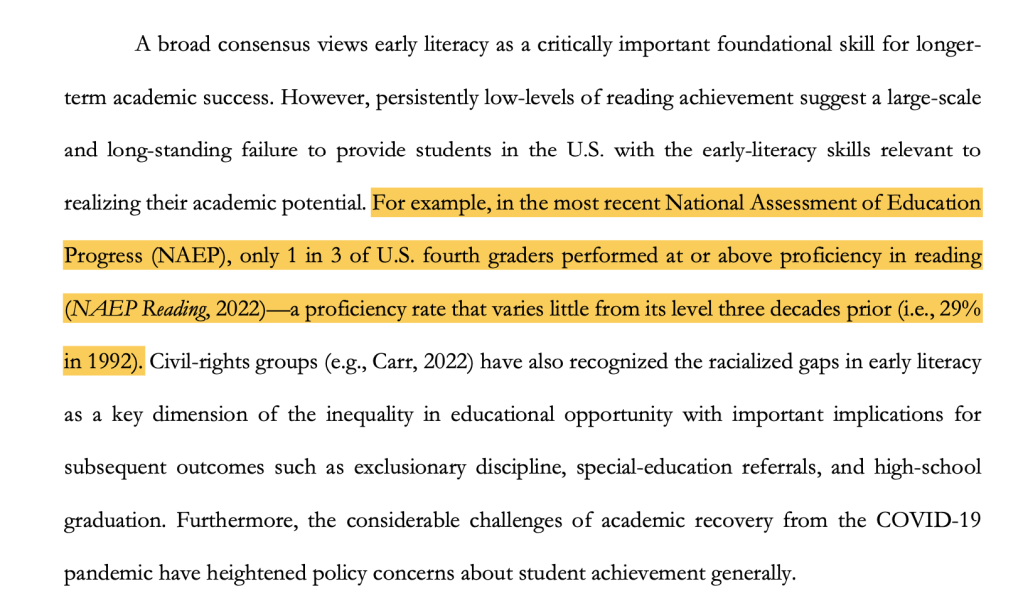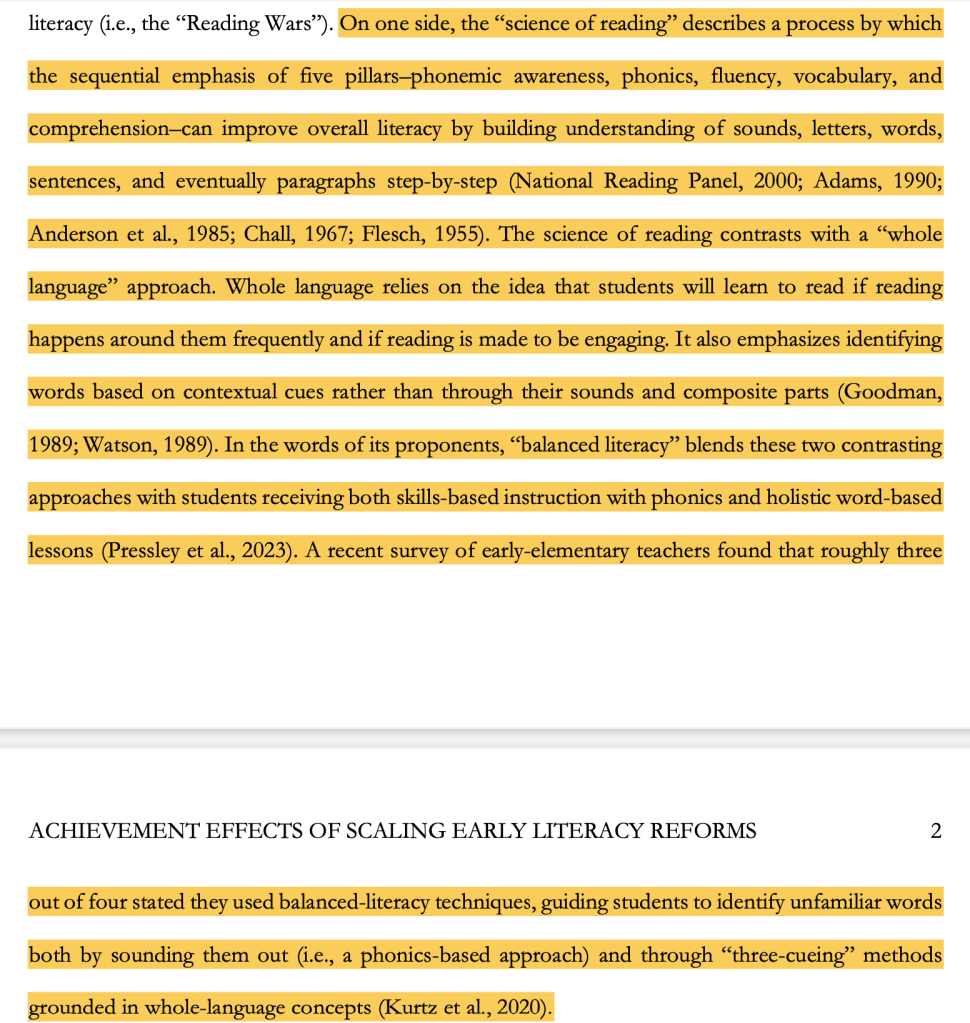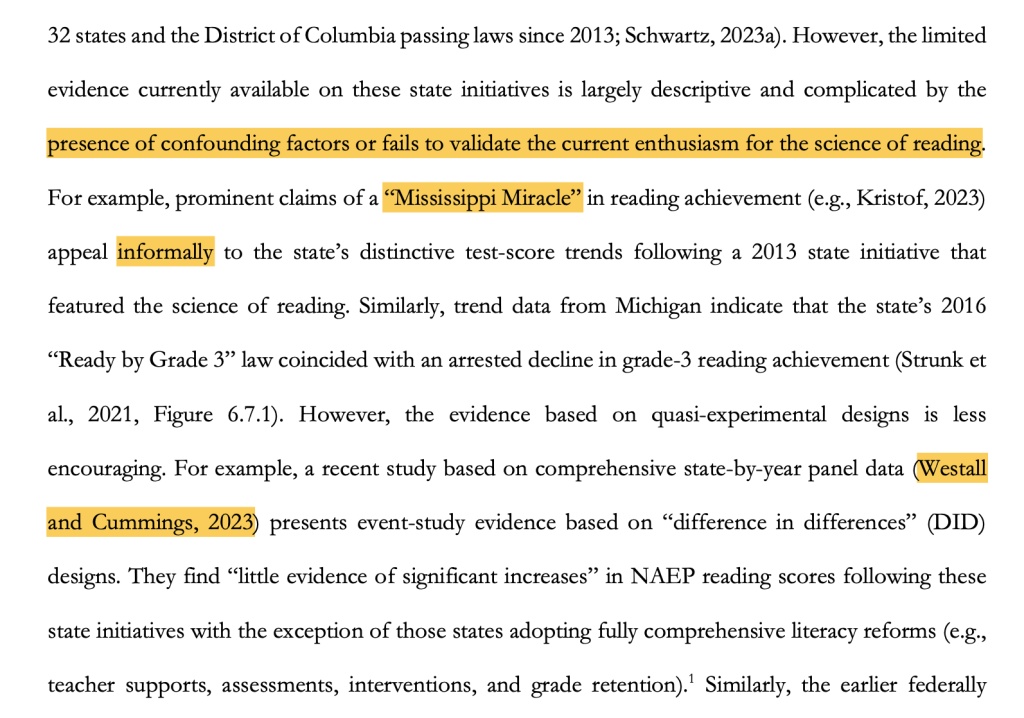Radical Eyes for Equity: Media Misreads Reading Science (Again)
For more than five years, mainstream media has been obsessed with two false but compelling stories: (1) there is a national reading crisis caused by balanced literacy programs that rely on three cueing, and (2) the solution is the “science of reading” (SOR).
So it is no surprise that a working paper on the outcomes from a right-to-read lawsuit in California has prompting immediate high-profile coverage in The Hechinger Report and The New York Times.
Before I examine the paper itself, let’s remind ourselves of two foundational aspects of the SOR movement that is primarily media- and politically based.
First, The Reading League has established what counts as “scientific”:

Second, advocates for SOR instruction such as NCTQ promise that SOR policy and practices will result in 90% of students reading at grade level proficiency:

Reading Foundations: Technical Report
If we maintain the essential foundations established by the SOR movement itself, we must conclude that the working paper itself should garner no media coverage because it fails to meet the standard of “scientific” and that even if we consider the findings of the paper credible, SOR policy has significantly failed in CA:
Now I want to unpack why the paper should never be covered at this level and with such a positive spin by journalists (including within the paper itself).
The most important issue is that a working paper is not peer-reviewed or published, thus not “scientific” per expectations identified above:

About EdWorking Papers
And as noted by Barshay: “The working paper, ‘The Achievement Effects of Scaling Early Literacy Reforms,’ was posted to the website of the Annenberg Institute for School Reform at Brown University on Dec. 4, 2023. It has not yet been published in a peer-reviewed journal, and may still be revised.”
Next, since there is a great deal of misinformation in the paper about NAEP and literacy, we should be concerned that the authors have backgrounds in social studies and economics, not literacy:
For scholars and journalists, not knowing enough to know what you don’t know can erode the credibility of research and journalism. This paper represents misrepresentations far too common in both research and media—misunderstanding NAEP reading proficiency:

Since “Basic” and not “Proficient” approximates grade level reading proficiency, NAEP data show that about 2 out of 3 students are at or above proficiency—not 1 out of 3.
Whether or not the US has a reading crisis and how scientific research can address reading proficiency in the US is negatively impacted by this simple fact: There is no standard metric for “proficiency” in reading, and NAEP along with each state sets the cut scores for proficiency differently.
Another misrepresentation or oversimplification in the paper is the failure to define clearly what counts as SOR as well as recycling oversimplified characterizations of whole language and balanced literacy:

At the center of misrepresenting reading theory and practices, this paper again significantly skews both what three cueing is and how it has or hasn’t impacted reading proficiency. [1]
The paper acknowledges two important points often misrepresented in the media: the Mississippi “miracle” is more story than science, and the last twenty years include research showing little to no positive impact from SOR policies grounded in NCLB, Reading First, and NRP:

Yet despite the high standard SOR has set for reading proficiency and the minimal gains shown in this paper, the authors slip into advocacy for SOR:

The paper lacks a clear definition of what counts as SOR (except it appears anything not including three cueing counts) [2] or reading proficiency, and skirts over that the policy implemented in CA includes far more than SOR literacy practices (suggesting any gains could be more from extra funding and other practices):


Media’s outsized coverage of this paper also raises questions about outliers and selective coverage.
The paper again notes a history of SOR practices not resulting in promised gains:

However, neither the paper nor mainstream media choose to focus on substantial evidence from England about failed SOR policies over almost two decades, and one must wonder why there isn’t the same media coverage for research on high-volume reading that has been peer-reviewed and published: The Effects of Bookworms Literacy Curriculum on Student Achievement in Grades 2-5.
The paper’s caveats also deserve far more emphasis than the findings:

Again, decades of research and contemporary examples from MS and FL have shown repeatedly that raising reading scores in the short term and early grades almost never continues into middle school, and thus are mirages, not miracles.
Finally, the paper represents two significant problems with so-called high-quality research in education: (1) using metrics such as “X [time] of learning” and (2) judging policy and practice in terms of “cost effective” (one researcher, again, has an economics background):

Finally, then, if we circle back to the standards and promises within the SOR movement, this working paper should not be covered at all by media (a working paper is more press release than science), but if anything, the results signal a significant failure of SOR practices to meet the 9 of 10 students reaching reading proficiency.
The media coverage of this working paper could be considered much ado about nothing except it will serve to continue the manufactured crisis campaign about reading that is ultimately, and again, mis-serving children, teachers, and the promises of public education.
[1] See the following:
- Understanding MSV: The Types of Information Available to Readers
- Is Reading a “Guessing Game”?: Reading Theory as a Debate, Not Settled Science
- Compton-Lilly, C.F., Mitra, A., Guay, M., & Spence, L.K. (2020). A confluence of complexity: Intersections among reading theory, neuroscience, and observations of young readers. Reading Research Quarterly, 55(S1), S185-S195. https://doi.org/10.1002/rrq.348 [access HERE]
- Mora, J.K. (2023, July 3). To cue or not to cue: Is that the question? Language Magazine. https://www.languagemagazine.com/2023/07/03/to-cue-or-not-to-cue-is-that-the-question/
[2] Since no standard exists for what counts as SOR practices, many states and schools seem to cherry pick what to ban and what to implement. For example, three cueing is often banned, but state and schools implement practices and programs also not supported by science such as LETRS training for teachers, grade retention, decodable texts, and multi-sensory (O-G) programs; see Teacher Prep Review: Strengthening Elementary Reading Instruction (NCTQ) and The Science of Reading: A Literature Review:

This blog post has been shared by permission from the author.
Readers wishing to comment on the content are encouraged to do so via the link to the original post.
Find the original post here:
The views expressed by the blogger are not necessarily those of NEPC.


